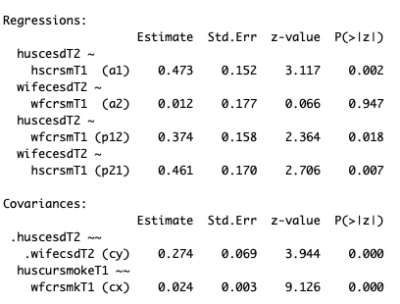In this two-day, virtual data expedition project, students were introduced to the APIM in the context of stress proliferation, linked lives, the spousal relationship, and mental and physical health outcomes.
Stress proliferation is a concept within the stress process paradigm that explains how one person’s stressors can influence others (Thoits 2010). Combining this with the life course principle of linked lives explains that because people are embedded in social networks, stress not only can impact the individual but can also proliferate to people close to them (Elder Jr, Shanahan and Jennings 2015). For example, one spouse’s chronic health condition may lead to stress-provoking strain in the marital relationship, eventually spilling over to affect the other spouse’s mental health. Additionally, because partners share an environment, experiences, and resources (e.g., money and information), as well as exert social control over each other, they can monitor and influence each other’s health and health behaviors. This often leads to health concordance within couples; in other words, because individuals within the couple influence each other’s health and well-being, their health tends to become more similar or more alike (Kiecolt-Glaser and Wilson 2017, Polenick, Renn and Birditt 2018). Thus, a spouse’s current health condition may influence their partner’s future health and spouses may contemporaneously exhibit similar health conditions or behaviors.
However, how spouses influence each other may be patterned by the gender of the spouse with the health condition or exhibiting the health behaviors. Recent evidence suggests that a wife’s health condition may have little influence on her husband’s future health conditions, but that a husband’s health condition will most likely influence his wife’s future health (Kiecolt-Glaser and Wilson 2017).
Graduate Students: Christina Kamis and Jessica S. West, Department of Sociology
Faculty: Professor Jenifer Hamil-Luker
Course: SOC 257
With two waves of couple-level data from the Health and Retirement Survey, students were first tasked with creating hypothetical APIM using relevant HRS variables. After developing research questions and hypotheses related to how wives’ and husbands’ health outcomes influence one another, students then tested these hypotheses by running an APIM in R. Students were instructed to interpret the output of the APIM to explore how wives’ and husbands’ mental and physical well-being at Time 1 influences wives’ and husbands’ health at Time 2. Additionally, students were to comment on whether there was any evidence of health concordance. In doing so, students were able to discuss the relationship between mental and physical health, how health outcomes spillover to impact spousal health outcomes, and how these relationships may differ across gender.
Guiding Questions
- What is the relationship between a wife’s health condition at T1 and her health condition at T2?
- What is the relationship between a husband’s health condition at T1 and his health condition at T2?
- What is the relationship between a wife’s health condition at T1 and her husband’s health condition at T2?
- What is the relationship between a husband’s health condition at T1 and his wife’s health condition at T2?
- Do you see evidence of health concordance at T1? T2?
- Choose one of your findings (Q2-Q6). Hypothesize why you might be witnessing the relationship you do.
The Dataset
This data expedition used the Health and Retirement Study (HRS) (2006-2012). The HRS is a publicly available, nationally representative dataset of adults over the age of 50 and their spouses that monitors changes in cognitive, physical, and functional health that are associated with aging. The core survey, which is fielded every two years to all participants (main respondents and spouses), includes information on demographic characteristics, physical health, mental health, and martial characteristics. In addition to the core HRS survey data, we also included publicly available supplemental data from the HRS Leave Behind Participant Lifestyle Questionnaire. In 2006, the HRS randomly selected 50% sample of survey respondents who completed the 2006 core survey to complete the Leave Behind Participant Lifestyle Questionnaire. In 2008, the other half of the respondents were eligible to complete the Leave Behind Questionnaire. This questionnaire included information on psychosocial variables such as social support, marital quality, and major life stressors. The 2006 cohort was remeasured again in 2010, and the 2008 cohort was remeasured again in 2012. Following previous research, we treated the 2006/2008 responses as Time 1 and the 2010/2012 measures as Time 2. Couples were matched on household identification number, which allowed us to identify individuals within the same marriage at Time 1 and Time 2.
Although the HRS includes many variables across multiple substantive topics, data for this data expedition included the following health conditions/behaviors (see Codebook for more details): depression, anxiety, disability (measured through activities of daily living), self-rated health, smoking status, drinking frequency, spousal support, chronic conditions, waist circumference, self-rated hearing, pain severity, and frequency of vigorous exercise.
Note: Data included in this report is a dummy-data set. HRS data cannot be shared with third-parties but is publicly available for download if third-parties complete a User Registration form.
In-Class Exercises
Prior to the first class, students were instructed to read an Annual Review of Clinical Psychology article by Kiecolt-Glaser and Wilson (2017) and watch two webinars that introduced the concepts of linked lives and stress proliferation as well as provided an overview of the HRS dataset.
In the first class, we reviewed the substantive material related to linked lives, spousal health concordance, and the link between physical and mental health. We also discussed how there might be gender differences in how spouses influence one another. Students were then sorted into breakout rooms to discuss and respond to a range of questions that would prepare students for developing research questions related to the APIM.
We then spent time introducing students to the Health and Retirement Study, in general, and the variables included in our data expedition dataset, specifically. Students individually created and submitted hypothetical APIM with the HRS variables from the curated data set, so they could develop research questions to test in the following class. See the figure below for an example of the hypothetical APIM that students might have submitted.

Prior to the second class, students watched a webinar that introduced R cloud, and how to do basic data analyses in R such as finding the average of a variable or looking at a cross-tabulation of two variables.
In the second class, students returned to their previous breakout rooms and were asked to use the HRS data and code available to them in R cloud to run an APIM. The code in R created output in the form of a regression table and a color-coded APIM plot that signaled both statistical significance and the direction of the relationships (see below for examples). Students used the table and the produced plot to answer the guiding questions about husband’s and wife’s health at Time 1 and Time 2. Students wrote responses to the Guiding Questions with their groups and submitted their responses to Sakai by the end of class.


Materials Included in “Data Expedition, KamisWest2021” folder:
- DataExp_dum.csv: dummy data set representing HRS data. HRS data cannot be shared to third-party members who are not under direct supervision of instructors (i.e. students) unless all third-party members personally fill and out return a User Registration form. Variable names in dummy data set match the HRS dataset used during the data expedition class, but all data is randomly generated and NOT representative of HRS data.
- DataExp.R: R script for analyzing DataExp.dta and creating APIM.
- DE1_webinar.pdf & DE1_HRSwebinar.pptx: two webinars assigned to students prior to the first class.
- DE1_class.ppt & DE1_HRSclass.pptx: two in-class powerpoint presentations for substantive content and introducing HRS data.
- DE1 Group Questions.docx: Groups questions for the first class provided to breakout rooms related to readings and presentations in-class.
- DE2 HRS_codebook.docx: codebook for DataExp.dta.
- DE2 Group Questions.docx: Groups questions for the second class provided to breakout rooms related to the APIM created in R cloud.
References
- Health and Retirment Study, public use data. Produced and distributed by the University of Michigan with funding from the National Institute on Aging (grant number NIA U01AG009740). Ann Arbor, MI, (2006-2012).
- Elder Jr, Glen H., Michael J. Shanahan and Julia A. Jennings. 2015. “Human Development in Time and Place.” in Ecological Settings and Processes in Developmental Systems, Vol. Volume 4 of R.M. Lerner (eds.) The Handbook of Child Psychology and Developmental Science, edited by M. Bornstein and T. Leventhal. New York, NY: Wiley.
- Epskamp , Sacha. 2019. “semPlot: Path Diagrams and Visual Analysis of Various SEM Packages’ Output”. R package version 1.1.2. https://github.com/SachaEpskamp/semPlot
- Kiecolt-Glaser, J. K. and S. J. Wilson. 2017. “Lovesick: How Couples’ Relationships Influence Health.” Annu Rev Clin Psychol 13:421-43. doi: 10.1146/annurev-clinpsy-032816-045111.
- Meyler, Deanna, Jim P. Stimpson and M. Kristen Peek. 2007. “Health Concordance within Couples: A Systematic Review.” Social Science & Medicine 64(11):2297-310.
- Polenick, C. A., B. N. Renn and K. S. Birditt. 2018. “Dyadic Effects of Depressive Symptoms on Medical Morbidity in Middle-Aged and Older Couples.” Health Psychol 37(1):28-36. doi: 10.1037/hea0000573.
- Rosseel, Yves. 2012. “lavaan: An R Package for Structural Equation Modeling.” Journal of Statistical Software, 48(2), 1-36. http://www.jstatsoft.org/v48/i02/.
- R Core Team (2020). R: A language and environment for statistical computing. R Foundation for Statistical Computing, Vienna, Austria. https://www.R-project.org/
- Thoits, Peggy A. 2010. “Stress and Health: Major Findings and Policy Implications.” Journal of Health and Social Behavior 51(1):S41-53. doi: 10.1177/0022146510383499.
- Thomeer, Mieke Beth, Debra Umberson and Tetyana Pudrovska. 2013. “Marital Processes around Depression: A Gendered and Relational Perspective.” Society and Mental Health 3(3):151-69.
- Waite, Linda J. and Maggie Gallagher. 2000. The Case for Marriage: Why Married People Are Happier, Healthier, and Better Off Financially. New York, NY: DoubleDay.
- Stas, L, Kenny, D. A., Mayer, A., & Loeys, T. (2018). Giving Dyadic Data Analysis Away: A User-Friendly App for Actor-Partner Interdependence Models. Personal Relationships, 25 (1), 103-119. DOI: 10.1111/pere.12230
Contact
Christina Kamis and Jessica S. West
christina.kamis@duke.edu or jessie.west@duke.edu


